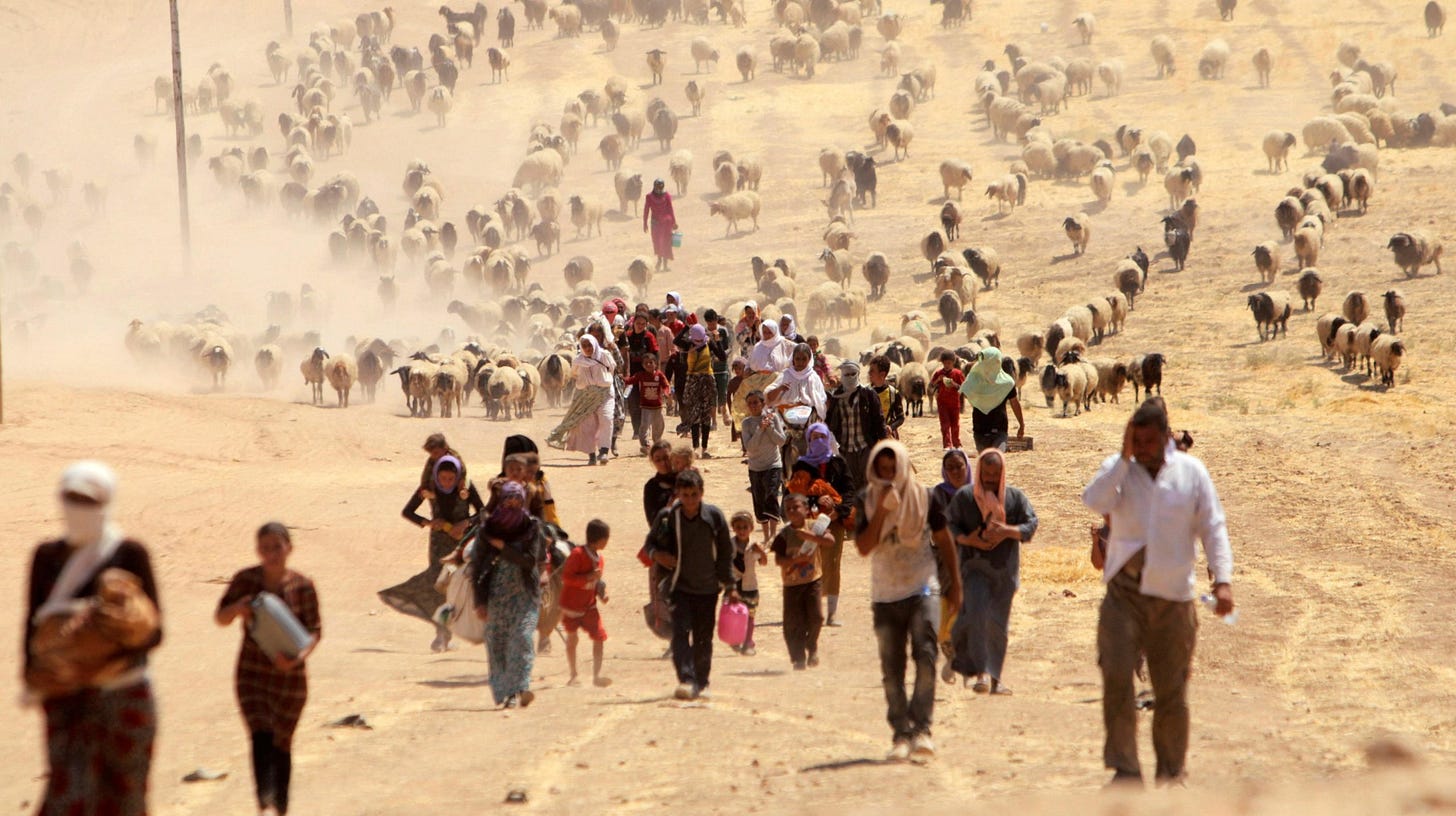Climate refugees and investing in mobility
Hamish Stewart of the Mobility, Climate Adaptation and Finance Working Group unpacks myths and highlights why we really need to care about sustaining migration - it's the economy!
Hello again!
One of the most common things raised when I have discussions on climate security with people in my life goes roughly like this: “well if the world’s weather gets crazier that’ll force people to move right? And then it becomes an immigration issue.”
Migration and immigration is an emotional topic for many, touching on individual stories of origin, seeking new opportunities, colonisation, nationalism, and identities lost, found and mixed. And with climate change induced migration getting more airtime, I thought we should lay the facts out, debunk myths and focus on solutions that’ll make a difference for the wellbeing of communities and countries.
To this I’m honoured to have Hamish Stewart speak to Securing our Climate!
Hamish is a Co-Chair of the Mobility, Climate Adaptation & Finance (MCAF) Working Group. He has spent over a decade working with banks, insurers, and institutional investors on climate change-related risk management, investment strategy, and policy engagement. While at the UN-backed Principles for Responsible Investment, Hamish worked on a number of their flagship climate programs, including the Net Zero Asset Owner Alliance Engagement Track. In 2014 he led the launch of the Legal Programme at the Asset Owners Disclosure Project in London. He holds an MSc from the London School of Economics and a Juris Doctor degree in law from the University of British Columbia.
Investors who want to learn more about MCAF’s work are invited to get in touch to discuss potential synergies with their existing investment research, stewardship and policy engagement programmes: hello@mcaf.global.
What is the purpose of the Mobility Climate Adaptation & Finance Working Group?
The Migration, Climate Adaptation and Finance Working Group (MCAF) empowers institutional investors to be a voice for rational, sustainable, and humane migration policy. Myself and a co-chair convene this group and serve as the Secretariat, with two Work Tracks. We also advocate for migration as an important climate adaptation tool. Our focus is on capital allocators in the G7 countries, where most institutional capital is domiciled and where there is an important opportunity to improve approaches to immigration policy and human capital planning. Via our events and private roundtables, MCAF educates and engages with investors on actionable opportunities and risks associated with human mobility and climate adaptation. We have been running for 18 months and will launch a new Phase 2 work programme with our Stewardship and Policy Tracks in September.
Why do people move, and what types of drivers of human mobility do the investors in your group analyse?
The environment is one of the many factors that shape migration patterns within large, continental countries like the United States, China, or India. Environmental factors - floods, droughts, and extreme weather events - can also drive cross border mobility. Depending on the context, climate impacts and other environmental drivers may be an indirect rather than a direct motivator for people to move. This makes it difficult to directly attribute migration to climate change and other environmental factors, so investors need to hone their research in this area. Because migration drivers are varied and shift over time, it is important for immigration policy and mobility systems to be in place to enable movement. Having people be able to move internally or across borders in response to disasters is essential to recovery, and most people return home as soon as it is safe to do so.
In fact, we expect human mobility and levels of immigration to continue in line with historical trends, regardless of spikes in response to climate or geopolitical events. Because it is mainly driven by significant economic, political and social processes, such as labour demand (in destination countries) and development in origin countries. As incomes rise, mobility increases, as we can see in domestic labour markets in India and China, for example. Migration requires considerable resources, particularly long-distance migration from rural areas to cities or abroad for work.
Most people move within their own countries and across borders in response to economic opportunities and other factors.
Extreme poverty, whether influenced or caused by climate and environmental stresses or not, is more likely to limit people’s ability to travel and migrate over large distances, and they might find themselves therefore trapped where they are, unable to flee. So investors need to first understand which types of mobility matter for their portfolio, then consider geography and time horizons, and do their research. Human mobility matters for investor returns and we encourage all investors to put in the time and resources to properly understand this issue. This is the first step in building consistent internal positions and strategies to support human mobility as a positive driver of productivity across asset classes.

Why should infrastructure investors be particularly interested in immigration policy?
For investors looking at infrastructure, construction or financial services allocations in EMDEs, remittances are key. In addition to the household-level impacts outlined above, the channelling through the domestic banking sector of remittances provides a steady source of deposits funding for the local banks intermediating these inflows. These inflows can also enhance the depth and stability of the overall banking system indirectly via consumption in the formal economy. In countries with high levels of remittances, there is a significant impact on the accumulation of central bank international reserves and indirectly on bank credit to the economy.
Because remittances tend to be stable and countercyclical relative to the recipient country’s economy, remittances support policymakers adopting fixed exchange rates and support local currency stability. Currency stability, in turn, is important for foreign investors in infrastructure projects, who rely on expectations of economic stability, even where they may have currency risk hedges in place.
As mentioned, most people move within their own countries and across borders in response to economic opportunities and other factors. Climate change will be one factor influencing this, alongside demographics and geopolitics, and other environmental and social drivers. Beyond the labour market impacts, mobility patterns impact capital flows and technology sharing and transfer, which shape economic outcomes. Around the world, about one in eight people participate in international remittances, for example, either sending or receiving funds, a key source of capital inflows in many countries.
Each year, at least US$1.8 trillion is sent person-to-person across borders, and this volume is expected to grow to US$3 trillion by 2030, mostly flowing from workers in developed economies to emerging markets and developing economies (EMDEs).
Remittances and cross-border person-to-person transfers represent the largest source of financial support to emerging markets, surpassing foreign direct investment and overseas development aid by a wide margin. In the context of climate disruption, labour mobility and these inbound capital flows become even more important as drivers of adaptation and resilience.
In over 150 EMDEs, remittances continue to grow rapidly, outpacing other financial inflows as a share of GDP, particularly in Asia and Africa. In a number of countries, including The Philippines, El Salvador, and Tajikistan, remittances account for up to 40% percent of GDP.
Beyond EMDEs, in advanced economies that require significant numbers of working age immigrants to support labour market needs, maintain pension and tax systems, and to maintain their quality of life, infrastructure investors hold the key to building out the housing and other public infrastructure required to support population growth via immigration. This is acutely important in ageing countries like Canada, the UK, the United States, and parts of Europe where public infrastructure is crumbling and access to affordable housing is under strain.

There is lots of talk about climate driving or amplifying mobility. In the noisy news cycle, how are investors processing this information and using it to update their investment strategy and asset stewardship approach?
Climate mobility is already contributing to new mobility patterns in large continental countries like the US, India, and China, and shifting potential future growth trajectories across regions. The Intergovernmental Panel on Climate Change (IPCC), among others, notes that parts of northern India, the Persian Gulf, the Gulf of California and the southern Gulf of Mexico are “already experiencing heat stress conditions approaching the upper limits of labour productivity and human survivability”. The risk of heat stress is particularly high in cities, which are the drivers of growth.
The World Bank’s Groundswell report on internal migration was one of the first to project climate-linked migration across dozens of individual countries using a standardised methodology. But since that report’s publication, there has been a pullback from some of the more dramatic estimates cited to support political panic on this issue. Some studies assume that everyone vulnerable to sea level rise and other climate risks would migrate across international borders, for example, make the potential future number sound larger than is plausible.
So there is an important body of work for investors to draw on, providing a range of estimates for different countries and regions, and also a new focus on enabling mobility and finding solutions that support human flourishing, rather than stirring panic over wildly large estimated numbers.
At MCAF, we see climate and migration policy nested in the larger issue of the need for more functional and stable immigration policy at the G7 and beyond. Immigration policy whiplash and incongruence creates uncertainty for everyone, damaging the lives of individuals and families and negatively impacting on investors. Investors have an important role to play in supporting a macro view for humane, stable global migration policy and working more closely on these same issues in their core markets.
Because mobility within countries and across borders is so fundamental to innovation and economic outcomes, industry and also firm-level returns - look at how human capital inputs drive S&P 500 returns, for example - investors need to develop coherent positions and views on immigration policy in their home markets and beyond. This is important to inform investment decision making, risk management and existing human capital strategies. Once a well articulated position on human mobility and immigration is agreed upon, this can be used to engage with companies and policymakers in climate mobility, and other immigration policy-related themes.

What about the idea that the West will be overwhelmed by climate migrants? Isn’t this a looming risk?
This is a framing of mobility and refugee policy that we are working to address and correct at MCAF. That’s because there is a strong narrative that climate change will trigger mass migration across borders and threaten wealthy countries. But this is not accurate and is a narrative pushed by private security firms, their public affairs consultants, outsourcing firms, populist politicians and others set to benefit from the securitisation and increasing militarisation of borders. Only a minority of people on the move who cross borders, estimated at 24% of the world’s refugee population, end up in wealthy countries.
The fear narrative also tends to focus on the notion of the world’s poorest people fleeing disasters to cross oceans and continents to overwhelm more sparsely populated advanced economies. This is also inaccurate, as the poorest people in the world simply cannot afford to move. Extreme poverty means that they are the least mobile, and disasters and wars mean they may actually become stuck in certain locations. By contrast to this narrative, focused on the notion of the global poor rising en masse to become globetrotters, it is in fact countries with rising incomes and access to education that are leaders in emigration. Educated, relatively wealthy populations are the ones that can move, and that benefits investors and national economies. Countries like India, Mexico, Morocco, Nigeria, Turkey and the Philippines are the source of many emigrant workers supporting the prosperity and future growth prospects of economies in Europe, North America, and the Gulf region.
Is the past a good indicator for investors and analysts on what’s to come on the human mobility front?
As Dutch academic Hein de Haas points out, the international migrant population, counted as a percentage of the world population, has remained remarkably stable at around 3 percent of the world population since 1960. Refugee numbers have shown more fluctuations from year to year, mainly depending on the level of conflict in origin areas and how these are classified. Still, over time the average refugee population numbers have been stable, representing 0.3 percent of the total world population, and about 10 percent of the total estimated number of international migrants. That means that there is roughly 1 refugee for every 350 people worldwide.
It makes no sense at all for politicians to suggest that their countries or the international community does not have the resources to provide refugees with a safe new home. These people need short term support and if provided with work visas are quickly able to contribute taxes and support economic productivity in their host countries. Investors can help to articulate this reality.
In the future, where will most refugees show up?
According to UNHCR about 86 percent of all refugees stay in developing countries, and this share has increased rather than decreased over time. It is countries such as Kenya, Chad, Uganda, Turkey, Iran, and Pakistan, who host large refugee populations, far more than might be coming to the UK or Canada [1]. Prior to the fall of the Assad regime, for example the large majority of Syrian refugees stayed in Turkey, Lebanon and Jordan, for example. Colombia and Brazil have been leaders on this issue, in response to Venezuela’s migration crisis. More than 2 million Venezuelans have obtained legal status under Colombia’s ten-year Temporary Protection Status policy, and Brazil has welcomed approximately 500,000 Venezuelans, matching many of them with job opportunities throughout the country [2].
The fundamental reality of mobility in times of crisis, whether it be natural disasters or war, is that people stay close to their home, moving internally or into a neighbouring country.
What types of policy framing could work better for investors than the current push to harden borders, building walls, and reduce mobility?
Rather than attempts to build walls and migrant detention camps in third countries, investors must encourage governments to consider more sustainable and rational approaches to human mobility and immigration policy. The MCAF Secretariat Letter to the G7 outlines some of these.
Examples of more effective policy frameworks include the Los Angeles Declaration on Migration and Protection. Under the LA Declaration, countries agreed to three-pronged approach to support human mobility and to (a) stabilize migrants where they are by offering them legal status and work permits, as well as surging additional economic support to the top host countries; and (b) expand legal pathways so that migrants enter countries safely on airplanes, already vetted and eligible to work, instead of crossing through perilous jungles and seas. Building these types of policy expectations into existing human capital and human rights policies would be a good first step for investors looking to engage on these issues in a productive and forward-looking manner. If investors need inspiration to support policies that enable labour mobility the success of labour mobility in supporting European economic development across the Schengen Area has many lessons.
What do effective climate mobility policies and strategies look like at the regional level?
There are a few examples for investors to look at which enable mobility as a climate adaptation strategy. A lot of work has been on the importance of enabling people to move and manage in onset disasters, covered in the Nansen Initiative. More recently, in November 2023, the Australia-Tuvalu Falepili Union Treaty was announced, which will allow up to 280 residents from the island of Tuvalu to migrate to Australia each year [2]. Under the treaty, Tuvaluans will be able to access key services in Australia, such as education, healthcare and the right to earn money, on arrival. the Pacific Regional Framework on Climate Mobility, which was adopted by Pacific Leaders in November 2023. It provides a coordinated approach to climate-related human mobility in the Pacific region. And free movement throughout the European Union was scaled up rapidly to allow refugees from Ukraine to quickly move throughout Europe when Russia invaded in 2022.

So then what’s the opportunity for investors, in changing climate risk and migration narratives on their heads?
The media focus is often on cross-border migration as a source of fear and panic inducing headlines, most often framing migrants as a national security threat. This is in spite of the large body of research, including from the IMF and others, showing that migration and enabling labour mobility has huge benefits for societies and local and global prosperity.
Levels of immigration mainly follow business cycles. Investors have an opportunity to address this reality and build policy that works for countries looking to grow and for people on the move looking for opportunities. The main challenge governments face is that it is impossible to reconcile the growing demand for labour and the need for more legal migration channels in ageing economies; and on the other hand to satisfy demands from some parts of the political spectrum for drastically lower immigration levels. Investors have to support a shift in narrative to support living standards and productivity growth and articulate the role of immigration in enabling this [5]. Investors can articulate this to their stakeholders, including, in the case of pension funds, to their beneficiaries who care about long run returns and market stability.
Investors who care about labour productivity and economic growth need to have an immigration policy engagement strategy. A high-level view and position on immigration policy in home markets is essential to inform portfolio-level strategy, but also in assessing regional and country-level growth and productivity profiles.
Climate migration policy and views can be developed once there is a higher level internal view. We think investors of all sizes can take inspiration from Norges Bank’s approach to developing internal policies on human capital and positions for external stewardship and policy engagement.
What are MCAF’s plans for the future?
We will be relaunching our Phase 2 programme in September 2025 and are actively looking for new Advisory Board members. We have exciting plans and encourage your readers interested in these themes to get in touch: hello@mcaf.global.




